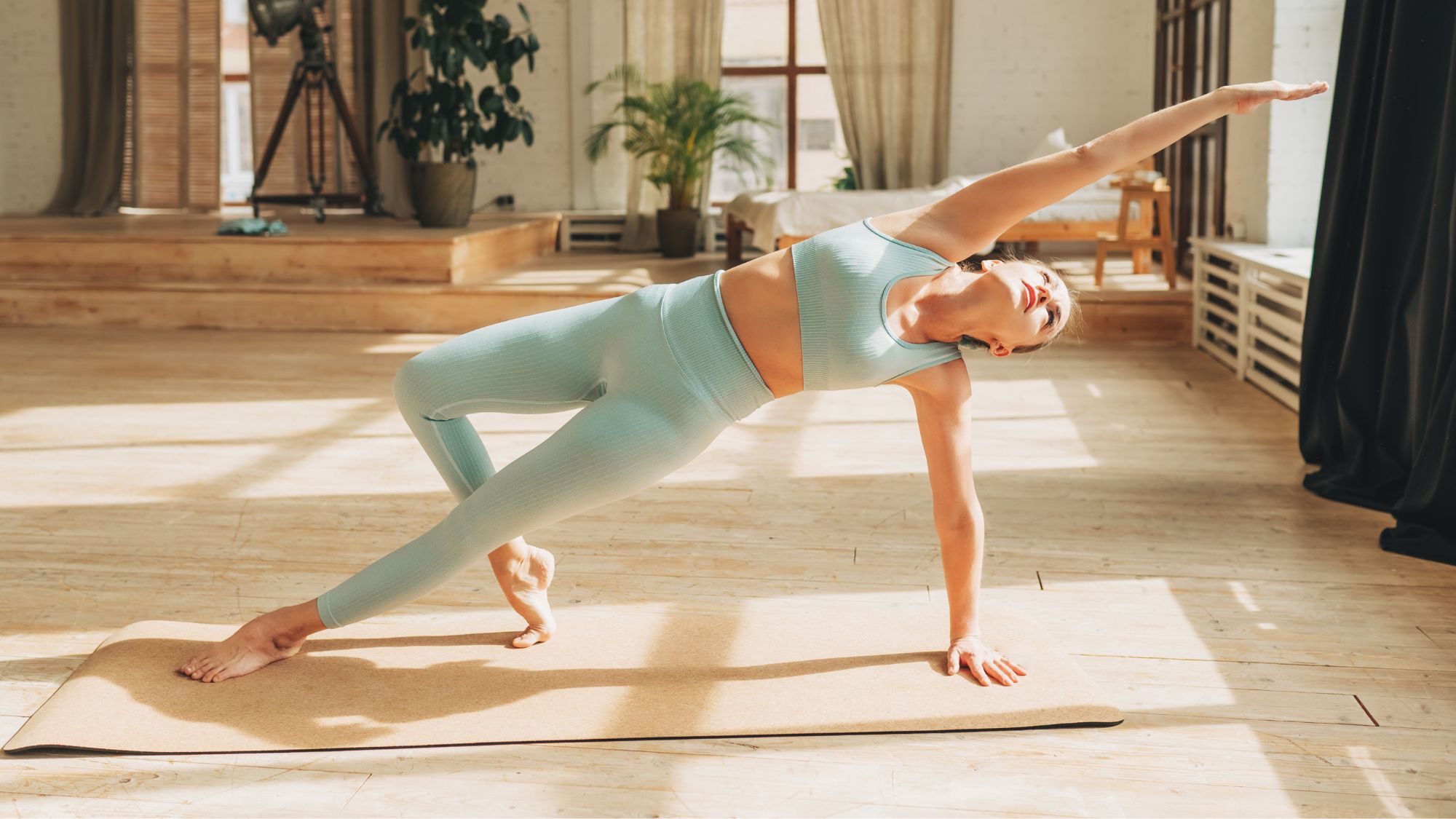Balance Is a Key Longevity Metric – Which Is Why Experts Reckon You Should Try Warrior 1 Yoga Pose
Heads, shoulders, knees and *pose*


If there’s one thing modern wellness has mastered, it’s the art of convincing us that longevity is within reach if we simply… try harder. From cold plunges to collagen gummies to sleep-tracking rings that judge us before breakfast, the cultural obsession with living better for longer has become a known aspiration. But after trawling through the science on how to achieve it, there’s one surprisingly simple marker that consistently pops up: balance.
Yes, balance, as in the humble ability to stand on one leg without wobbling like a newborn deer. It turns out this underrated skill may reveal more about our long-term health than we ever realised. Case in point: a 2022 study published in the British Journal of Sports Medicine found that middle-aged and older adults who couldn’t stand on one leg for 10 seconds had almost double the risk of dying prematurely compared to those who could. Not exactly the wellness hack you’ll find trending on TikTok, but compelling nonetheless.
Another review published in Frontiers in Ageing Neuroscience went further, suggesting that balance isn’t just a reflection of coordination; it's an indicator of cognitive health, neuromuscular communication, and overall physiological resilience. Essentially, if your body and brain can still coordinate a one-legged stance without panicking, they're probably doing a decent job overall.
So where does yoga’s Warrior 1 come in? Historically known as Virabhadrasana I, Warrior 1 is a foundational standing pose that has existed in modern yoga since the early 20th century, popularised through styles like Ashtanga yoga and Hatha yoga. While it’s not the classic “balance pose” you might associate with standing on one leg, teachers consistently rank it as one of the most effective ways to build the kind of stability, strength, and body awareness that support better lifelong balance.
While not a beginner's yoga pose, Personal trainer Aimee Victoria Long says balance “isn’t just about coordination; it’s deeply connected to the body’s overall stability, muscular strength, and nervous system health.” She adds that yoga enhances proprioception - the internal GPS that tells you where your limbs are in space - and strengthens the smaller stabilising muscles that protect joints. That combination, she explains, “helps preserve mobility, independence, and overall vitality over time.”
In other words, if longevity is the goal, balance is one of the metrics worth placing front and centre. And Warrior 1? It might just be one of the simplest, most accessible places to start.
Keen to read more about the zen-boosting, flexibility-enhancing yoga moves? Don't skip our guides to the best 10-minute yoga workouts, best 20 minute-yoga workouts, and best yoga flows for core strength, plus team MC UK's favourite Yoga with Adriene classes, here. We've also got round-ups of the best yoga for flexibility, yoga for lower back pain, and yoga for energy flows, plus how one health contributor got on trying a yoga headstand every day, here.
Celebrity news, beauty, fashion advice, and fascinating features, delivered straight to your inbox!
Balance Could Be The Key to Living Longer - Here's What An Expert Yoga Instructor Has to Say About Warrior 1
Why do experts claim balance is key to longevity?
While we tend to think of balance as something you either “have” or “don’t”, it’s actually a complex interaction between the eyes, inner ears, proprioceptive nerves, muscular strength, and brain-body communication. When those systems age, degrade, or lose efficiency, our balance tends to follow.
Long describes balance as “a marker of how well the brain and body communicate.” As we age, this becomes particularly important: falls are one of the biggest causes of injury in older adults, and improving balance is one of the most effective ways to reduce that risk.
MoreYoga instructor Scarlett Woodford agrees, emphasising that balance “blends into various parts of life we don’t even notice day to day - like being able to walk in a straight line or step sideways out of a car confidently.” She notes that good balance also improves reaction time. “If you lose your footing suddenly, good balance, strength, and reaction time could make the difference between a small stumble and a bigger fall.”
It’s not just a muscular issue, either. Woodford explains that much of our balance comes from the eyes and inner ear - systems that can be trained, supported, and strengthened with consistent practice. Breathwork, eye-tracking drills, and even reducing stress can influence how steady we feel.
Put simply: balance is functional, foundational, and directly tied to healthier ageing. And while it naturally declines over time, it’s highly trainable, especially through mindful movement practices like yoga.
What is the Warrior 1 pose in yoga?
Warrior 1 (Virabhadrasana I) is one of yoga’s most recognisable standing poses. Traditionally, it represents strength, focus, and groundedness, qualities that mirror the physical benefits it builds.
The stance is asymmetrical: one foot steps forward, knee bent, while the back foot turns out around 45 degrees. The hips aim to face forward (though modern teachers emphasise that “square-ish” is more realistic), arms lift overhead, and the torso rises long through the spine.
While it’s been a staple of yoga for decades, its popularity has surged thanks to its accessibility across levels. It appears in everything from gentle Hatha classes to dynamic Vinyasa flows, acting as a bridge between strength, balance, and flexibility work.
Woodford notes that what makes Warrior 1 unique is the asymmetry. “The hips are squared forward away from the back leg, providing a great stretch for the back hip flexors but adding to the potential for misalignment.” Unlike Warrior 2, where the hips open outward and the feet align more evenly, Warrior 1 challenges the body to stabilise in a twisted, multi-directional way - excellent for balance, but also why the pose can feel unsteady.
What are the benefits of practising Warrior 1 in yoga?
1. It builds foundational balance
Warrior 1 requires multiple parts of the body to work together: the feet grounding, the legs stabilising, the hips aligning, and the torso lifting. Woodford describes this as “many parts of the body syncing and working together,” which is the very definition of functional balance.
Long adds that balance practices “train focus and mindfulness,” which can reduce stress and support hormonal and cardiovascular health - two major pillars of longevity.
2. It strengthens key stabilising muscles
Yoga is famously quadricep-dominant, and Warrior 1 strengthens the quads of the front leg while engaging the glutes, core, and smaller stabilisers in the feet and ankles. These muscles are essential for fall prevention, joint support, and everyday stability.
3. It improves spatial awareness
Long highlights yoga’s ability to enhance proprioception - the awareness of where your body is in space - which becomes crucial for mobility and independence with age.
4. It improves your coordination
Your body constantly makes tiny shifts in Warrior 1 to keep you upright. This continuous feedback loop between brain and body lead to micro-adjustments that train the neuromuscular system, which in turn, improves coordination and reaction time.
5. It stretches the hip flexors and opens the chest
The backwards-angled leg gets a deep hip flexor stretch, counteracting modern desk-based stiffness, while the lifted arms help open the shoulders and ribcage.
6. It’s easily adaptable
Many people experience wobbliness in Warrior 1. Woodford advises widening the stance “as if you’re on two sides of a train track rather than a tightrope.” This creates a more stable base and reduces strain on the back knee.
How to perform Warrior 1 with good form
To try Warrior 1 yourself, start by stepping one foot forward and the other back, keeping your stance wide - think two train tracks rather than a tightrope - to create stability. Turn the back foot out to around 45 degrees (or more if your knee prefers it), bend into the front knee, and allow the hips to face forward without forcing them. As you root down through both feet, lift the torso tall, reach the arms overhead, and engage the core and glutes to support the lower back. Hold for a few steady breaths before switching sides, noticing how the body makes tiny micro-adjustments to keep you upright.
It’s a simple sequence, but it encapsulates exactly why Warrior 1 earns its place in any longevity-focused routine: it strengthens the muscles that keep us stable, stretches areas that tighten with age, trains proprioception, and builds the brain–body communication that underpins lifelong balance. One pose won’t transform your health overnight, but as part of a balanced, mindful practice, it’s a powerful investment in how you move and how you age.
Shop MC-approved yoga essentials

A sturdy pair of grip socks helps you stay stable during every pulse, lift, and stretch, so you can focus on your form without slipping. I always keep a pair of lululemon Find Your Balance Grip Tab Socks in my workout bag just in case - and I'm a big fan of the cushioned, grippy sole and secure fit.

It’s easy to fall into the trap of thinking that using props to assist you makes you less of a Yogi. But that couldn’t be further from the case. Having equipment, such as a yoga block, can help you relax more into postures, finding a deeper range of motion and more tension release.
What is the Warrior 1 pose good for?
Warrior 1 (Virabhadrasana I) is a powerful standing yoga pose that builds lower body strength, improves balance, and enhances flexibility in the hips and shoulders. It engages the quads, glutes, and core while opening the chest - making it a full-body move that supports better posture and functional stability.
What other yoga poses help with balance and longevity?
Tree Pose (Vrksasana), Warrior 3 (Virabhadrasana III), and Chair Pose (Utkatasana) are all excellent complements to Warrior 1. Together, they target different stabilising muscles and challenge your coordination - keeping your brain, body, and balance in sync for the long run.

Georgia Brown is a freelance journalist covering fashion, lifestyle, heath and fitness. With bylines in Harper’s Bazaar, Women’s Health, and HELLO! where she formerly held the position of Senior Lifestyle & Fashion Writer, she’s also the co-founder of run club Sunnie Runners and is a devoted marathoner. With a particular love for sustainable fashion and slow living, Georgia can often be found sifting through London's best vintage stores to find the best pre-loved pieces.
